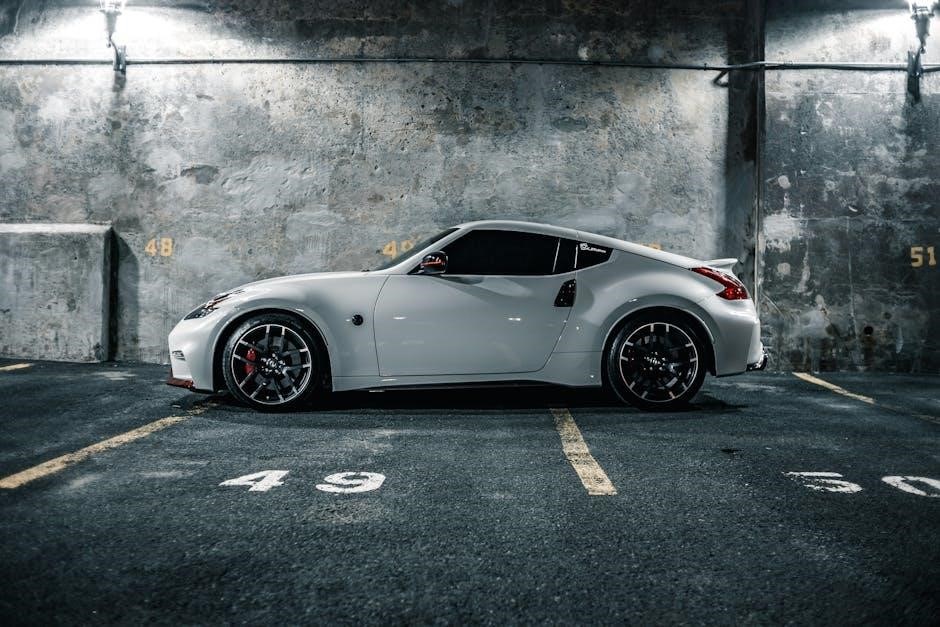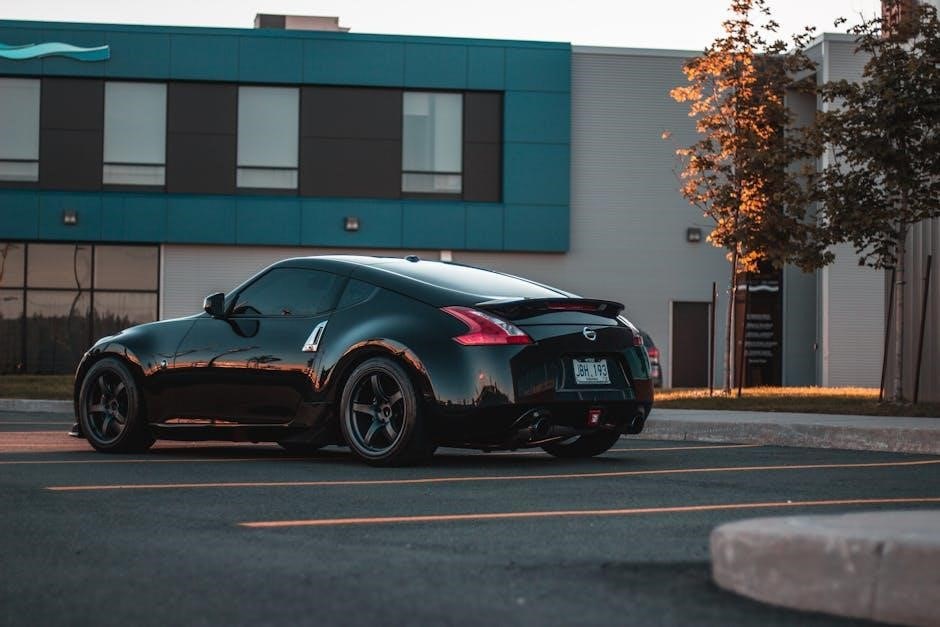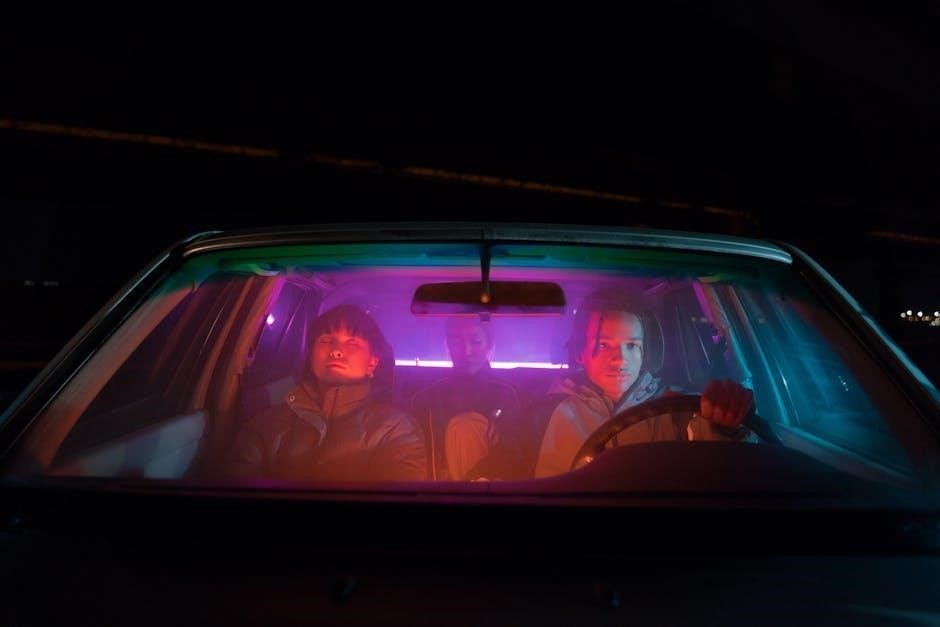car tint guide
Car window tinting is a thin coating applied to glass for aesthetic and functional purposes‚ reducing UV rays‚ heat‚ and glare while enhancing privacy and style.

Benefits of Car Window Tinting
Car window tinting enhances comfort‚ safety‚ and style by reducing UV rays‚ heat‚ and glare‚ while improving privacy and aesthetics for a superior driving experience.
UV Protection
Car window tinting offers exceptional UV protection‚ blocking up to 99% of harmful ultraviolet rays. This helps prevent skin damage‚ reduces interior fading‚ and shields passengers from sun exposure. The tint acts as a protective barrier‚ maintaining the car’s interior quality and providing long-term benefits for both occupants and vehicle longevity. UV protection is a key advantage‚ making window tinting a practical solution for health-conscious drivers seeking to enhance their driving experience while preserving their car’s condition.
Heat Reduction
High-quality window tint films significantly reduce interior heat by blocking solar radiation‚ lowering temperatures by up to 60%. This enhances comfort‚ reduces the need for air conditioning‚ and improves fuel efficiency. Heat reduction also prevents upholstery fading and extends the lifespan of interior components. By minimizing heat entry‚ window tinting creates a cooler‚ more enjoyable driving environment for both drivers and passengers‚ making it a practical and energy-efficient solution for everyday use.
Glare Reduction
Window tinting effectively reduces glare from sunlight and headlights‚ enhancing visibility and driving safety. By minimizing harsh light reflection‚ it decreases eye strain and distractions‚ especially during sunny days or nighttime driving. This improvement in visual clarity allows drivers to focus better on the road‚ reducing the risk of accidents. Glare reduction is one of the most appreciated benefits of window tinting‚ contributing to a safer and more comfortable driving experience for all vehicle occupants.
Privacy and Security
Window tinting enhances privacy by reducing visibility into the vehicle‚ making it difficult for outsiders to see valuables or occupants. This added layer of privacy deters potential thieves and provides a sense of security. Additionally‚ tinted windows can hold shattered glass together in the event of a breakage‚ preventing injuries and maintaining the vehicle’s integrity. This feature not only protects against smash-and-grab incidents but also offers added safety during accidents‚ making it a practical choice for concerned drivers.
Enhanced Aesthetics
Window tinting elevates your car’s visual appeal by adding a sleek‚ modern look. Available in various shades and finishes‚ it allows for customization to match your vehicle’s style. Tinted windows create a uniform appearance‚ making your car stand out on the road. The reflective properties of certain films can add a sporty or luxurious vibe‚ while others offer a subtle‚ elegant finish. This enhancement not only personalizes your ride but also complements its original design‚ boosting its overall aesthetic appeal and resale value.

Types of Window Tint Films
Window tint films come in dyed‚ ceramic‚ and metallic options‚ each offering unique benefits like UV protection‚ heat reduction‚ and enhanced aesthetics to suit different preferences and needs.
Dyed Window Tint
Dyed window tint is a cost-effective option where a layer of dye is applied to absorb solar radiation‚ reducing heat and glare. It is a popular choice for its affordability and ease of installation. However‚ the dye can fade over time‚ requiring replacement. While it offers decent UV protection and enhances privacy‚ it is less durable compared to ceramic or metallic films. Dyed tints are a practical solution for those seeking a budget-friendly way to improve comfort and aesthetics in their vehicle.
Ceramic Window Tint
Ceramic window tint is a premium option utilizing advanced nano-ceramic technology for superior performance. It offers exceptional UV protection‚ blocking 99% of harmful rays‚ and excels in heat rejection‚ reducing interior temperatures significantly. Known for its clarity and durability‚ ceramic tint resists fading and lasts longer than dyed films. While it is more expensive‚ its outstanding performance and ability to enhance comfort and safety make it a top choice for drivers seeking long-term benefits and a professional finish.
Metallic Window Tint
Metallic window tint incorporates tiny metal particles for enhanced reflective properties‚ effectively reducing heat and glare. It provides a sleek‚ mirror-like appearance and improves privacy. However‚ its reflective nature may interfere with electronic signals like GPS or radio reception. While it excels in heat reduction‚ it’s important to consider compatibility with your vehicle’s technology before installation. This tint is durable but may lack the clarity of ceramic options‚ making it a trade-off between style and functionality.

Tools and Materials Needed
Essential tools include a squeegee‚ heat gun‚ razor blade‚ spray bottle with soapy water‚ and a lint-free cloth. Materials required are precut tint kits‚ cutting tools‚ and application solutions for a smooth installation process.
Essential Tools
To achieve a professional window tint installation‚ essential tools include a squeegee for removing air bubbles‚ a heat gun for smoothing curves‚ a razor blade for trimming excess film‚ and a spray bottle with soapy water for application. A lint-free cloth is necessary for cleaning surfaces‚ ensuring optimal adhesion. Additionally‚ a precision knife or utility knife is useful for cutting the tint film accurately. These tools ensure a smooth‚ bubble-free installation and a long-lasting finish for your car windows.
Materials Required
Key materials for car window tinting include high-quality tint films (dyed‚ ceramic‚ or metallic)‚ precut tint kits for specific car models‚ and a cleaning solution with a lint-free cloth. Adhesive removers are essential for removing old tint residue; Additional supplies like application fluid (soapy water) ensure a smooth installation. Selecting the right material ensures a professional finish‚ durability‚ and optimal performance in UV protection‚ heat reduction‚ and glare minimization. Proper film selection enhances both functionality and aesthetics for your vehicle.
Car Window Tint Installation Process
The process involves preparing the window‚ applying the tint film‚ and ensuring a smooth‚ bubble-free finish. Tools like squeegees and heat guns aid in achieving professional results.
Preparing the Window
Preparing the window is crucial for a successful tint installation. Clean the glass thoroughly with a lint-free cloth and a suitable cleaning solution to remove dirt‚ dust‚ and grease. If the window already has tint‚ remove it using a razor tool or adhesive remover. Ensure the surface is completely dry and free of debris. This step ensures proper adhesion of the tint film‚ preventing bubbles and peeling. A clean‚ dry surface is essential for a professional finish.
Applying the Tint Film
Apply the tint film by spraying the window with soapy water for a smooth surface. Align the film with the window edges‚ starting from the top and working downward. Use a squeegee to press out air and water bubbles‚ ensuring a tight fit. For curved windows‚ use a heat gun to gently shrink the film‚ ensuring it conforms without creasing. Trim excess film around the edges with a razor blade and press the edges firmly to secure the tint in place.
Finishing Touches
After applying the tint film‚ use a squeegee to remove any remaining air bubbles or water. Trim excess film around the edges with a razor blade for a clean finish. Use a heat gun to ensure the film conforms to curved surfaces‚ then press the edges firmly to secure the tint. Allow the film to set for a few days before cleaning. Avoid using harsh chemicals to preserve the tint’s integrity and ensure long-lasting protection and clarity.

Post-Installation Care and Maintenance
Allow the tint to set for a few days before cleaning. Use a soft cloth and avoid harsh chemicals to maintain the film’s integrity. Regularly inspect for edge lifting and press firmly to ensure longevity. Proper care ensures the tint remains effective‚ protecting your car’s interior and preserving its aesthetic appeal over time.
Immediate Aftercare
After installation‚ allow the tint to cure for a few days before cleaning. Avoid rolling down tinted windows for at least 48 hours. Use a soft‚ lint-free cloth to wipe the glass‚ avoiding harsh chemicals or ammonia-based cleaners. For curved windows‚ apply moderate heat with a heat gun to ensure proper adhesion. Inspect for small bubbles and gently press them with a squeegee or pin to eliminate air pockets. Proper immediate care ensures a smooth‚ bubble-free finish and extends the film’s lifespan.
Long-Term Maintenance
Regularly clean the tint with a soft‚ lint-free cloth and mild soap to prevent dust buildup. Avoid using harsh chemicals or abrasive materials‚ as they can damage the film. Periodically inspect the edges to ensure they remain securely attached‚ pressing them gently if needed. For minor imperfections‚ a heat gun can be used cautiously to smooth wrinkles. Regular maintenance ensures the tint remains effective‚ preserving its appearance and protective qualities over time.
Troubleshooting Common Issues
Common issues like bubbles‚ peeling‚ and fading can arise. Address them promptly with tools like heat guns or needles to prevent damage and maintain effectiveness.
Bubbles and Creases
Bubbles and creases are common issues during installation. To fix bubbles‚ gently puncture them with a needle and press the area with a squeegee. For creases‚ use a heat gun to soften the film‚ then smooth it out. Avoid excessive heat to prevent damage. Regularly inspecting and addressing these issues ensures a professional finish and maintains the tint’s effectiveness. Proper tools and techniques are essential for resolving these problems effectively.
Adhesive Issues
Adhesive issues‚ such as peeling or lifting at the edges‚ can occur due to moisture‚ dirt‚ or improper installation. To fix‚ press the edges firmly and ensure the surface is clean and dry. Using a heat gun gently can help reactivates the adhesive. Prevent issues by ensuring proper surface preparation and avoiding excessive soapy water during installation. Regular inspections and prompt corrections can maintain the tint’s adhesion and longevity.
Peeling and Fading
Peeling and fading occur due to exposure to sunlight‚ poor installation‚ or low-quality films. UV rays can weaken adhesives‚ causing peeling‚ while fading results from dye degradation. Ceramic tints resist these issues better than dyed films. Regular inspections and addressing peeling early can prevent further damage. Avoid using harsh chemicals for cleaning‚ as they may accelerate fading. High-quality films and proper installation are key to maintaining durability and appearance over time.
